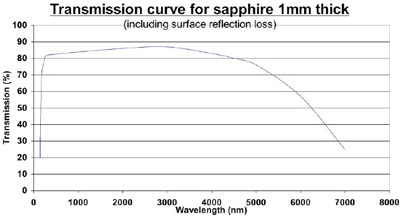Background
Goodfellow Ceramic & Glass Division are an award-winning company who supply specialist glass and ceramics for scientific and industrial use.
Goodfellow Ceramic & Glass Division aim is to understand your application and then supply the most appropriate materials or components to meet your needs.
Our technical staff are qualified in glass technology and materials science and can, therefore, provide impartial advice and full technical support for your projects.
Sapphire Glass
Sapphire can offer the ideal solution for applications where standard glass and technical ceramics are not sufficient. Superior physical, chemical and optical properties allow sapphire to be used in demanding conditions.
Sapphire is transparent, single crystal aluminium oxide. Sometimes, particularly for sapphire balls, a slight trace of chromium oxide is added which gives it a “ruby” colour. The material can be made in different ways which affects the properties, particularly optical properties, and the shapes which can be manufactured.
Advantages of Sapphire
The advantages of sapphire include:
- Excellent optical characteristics, UV to IR
- High wear and scratch resistance
- High operating temperature (1800°C)
- Chemically inert
- High strength
- High electrical resistance
- High thermal conductivity
Applications of Sapphire
Applications Applications of sapphire include:
- Optics
- Engineered components
- Substrates
- High pressure windows
- Precision spheres
Properties of Sapphire
Table 1. Typical properties of sapphire.
| |
Property |
Units
|
Value
|
| General |
Chemical Formula |
n/a
|
Al2O3
|
| Density |
g/cm3
|
3.98
|
| Mechanical |
Compressive Strength |
MPa
|
2000
|
| Flexural strength |
MPa
|
480-900
|
| Young's Modulus |
GPa
|
350
|
| Thermal |
Max. Use Temperature |
°C
|
1800
|
| Thermal Conductivity |
W/m.K
|
40
|
| Co-Efficient of Linear Expansion |
10-6/°C
|
8.0
|
| Electrical |
Volume Resistance |
ohm.cm
|
1014
|
| Dielectric Constant |
|
9.4-11.5
|
| Dielectric Strength |
kV/mm
|
48
|
Note: Sapphire is anisotropic, i.e. some properties are not the same in all directions.

Figure 1. Transmission curve for 1mm sapphire (including surface reflection look).
Properties of sapphire shown are typical values, they are not absolute material properties, and should be used for guidance only. It is recommended that materials and components are tested for their suitability for a specific application.

This information has been sourced, reviewed and adapted from materials provided by Goodfellow Ceramic & Glass Division.
For more information on this source, please visit Goodfellow Ceramic & Glass Division.